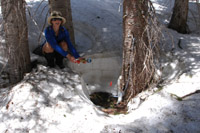- Home
- About S&T
- Taxa/Organisms
- Ecosystems
- Issues
- Methods & Tools
- Reports & Publications
- Location
- Search
Publisher: USGS | Science Center: Upper Midwest Environmental Sciences Center (UMESC, LaCrosse) | Format: URL
www.umesc.usgs.gov — This web resource provides decision makers with the information needed to maintain the Upper Mississippi River System as a viable multiple-use large river ecosystem. This resource also includes Data and sampling information, publication links, reports, other related documents and statistics, as well as links to field stations and other projects More...

Publisher: Other Federal Agency (National Park Service (NPS)) | Format: URL
science.nature.nps.gov — This website represents National Park Service Inventory and Monitoring Program's goal to collect, organize, and make available natural resource data and to contribute to the Service's institutional knowledge. Its goals are to inventory the natural resources under National Park Service stewardship to determine their nature and status; monitor park More...

Publisher: USGS | Science Center: Western Fisheries Research Center (WFRC, Seattle) | Format: URL
wfrc.usgs.gov — The whole study, conducted at Fort Benning, Georgia, partially funded through the US Army, involves testing of water and soil quality, physical and biotic indicators of stress at both the population and community level. Anthropogenic stress in the present study comes from disturbance by vehicles, particularly tanks used in army training, and from More...

Publisher: USGS | Science Center: Fort Collins Science Center (FORT, Ft. Collins) | Format: URL
www.fort.usgs.gov — Encroaching development, overuse, and air- and waterborne contaminants from outside park boundaries are causing noticeable changes to water quality and ecosystem health and functioning. The Front Range metropolitan area from Fort Collins south to Colorado Springs includes 75 percent of Colorado's population and its most productive agricultural More...

Publisher: USGS | Science Center: Western Fisheries Research Center (WFRC, Seattle) | Format: URL
wfrc.usgs.gov — In an attempt to decrease pesticide pollution of aquatic ecosystems, we have begun a project to develop biological control agents to protect plants against fungal diseases. This study has three objectives: (1) understanding how fungi cause disease; (2) understanding how plants that are symbiotic with certain fungi are resistant to fungal diseases; More...

Publisher: NBII | Format: URL
www.nbii.gov — Natural resource managers face complex decisions that require a clear understanding of the status of wildlife populations and their habitats. Monitoring is key to making effective management decisions and evaluating the outcomes of those decisions. The goal of NRMP is to improve the accessibility of monitoring efforts to resource managers to aid More...

Publisher: USGS | Science Center: Fort Collins Science Center (FORT, Ft. Collins) | Format: URL
www.fort.usgs.gov — Natural Resource Monitoring Partnership (NRMP) is a collaborative effort by the natural resource management community to improve monitoring efforts in order to support effective evaluation and decision-making by sharing information on monitoring projects and protocols. The Natural Resource Monitoring Partnership was built for easy access to More...

Publisher: NBII | Format: URL
frames.nbii.gov — The Fire Research And Management Exchange System or FRAMES is a systematic method of exchanging information and transferring technology between wildland fire researchers, managers, and other stakeholders. In partnership with the US Geological Survey's National Biological Information Infrastructure (NBII) Program, FRAMES is implementing web-based More...

Publisher: USGS | Science Center: Florida Integrated Science Center (FISC, Gainesville) | Format: URL
fl.biology.usgs.gov — Invasive nonindigenous species are important because they threaten native communities, alter habitats, and can have significant economic impacts. In aquatic environments, invasive species can be especially noxious because native species have few options for escaping direct interactions such as predation and competition for habitat and food. This More...

Publisher: USGS | Science Center: Upper Midwest Environmental Sciences Center (UMESC, LaCrosse) | Format: URL
www.umesc.usgs.gov — Aquatic vegetation flourished in the 1930s immediately after the locks and dams were constructed to accommodate barge traffic on the Upper Mississippi River System (UMRS). The distribution of aquatic vegetation, however, has fluctuated drastically in the 1980s and 1990s. As the navigation system ages, the fate of this important ecosystem component More...
